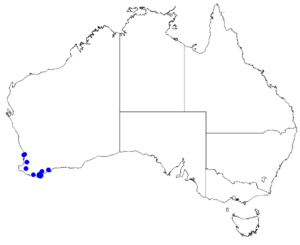Boronia crassipes facts for kids
Quick facts for kids Boronia crassipes |
|
|---|---|
| Conservation status | |
| Scientific classification | |
 |
|
| Occurrence data from Australasian Virtual Herbarium |
Boronia crassipes is a type of plant that belongs to the citrus family, called Rutaceae. It grows only in the south-west part of Western Australia. This plant is a tall, thin shrub. It has smooth, simple leaves. Its flowers are pale red or pale purple and have four petals.
Contents
What Does Boronia Crassipes Look Like?
Boronia crassipes is a tall, thin shrub. It can grow from about 0.5 to 3 metres (1.6 to 9.8 feet) tall. Its leaves are simple and shaped like narrow lines or ovals. They are usually between 10 and 15 millimetres (0.39 and 0.59 inches) long.
The flowers grow one by one where the leaves meet the stem. Each flower sits on a club-shaped stalk, called a pedicel, which is about 6 millimetres (0.24 inches) long.
Each flower has four red parts called sepals. These sepals are narrow and triangular, about 2 to 3 millimetres (0.079 to 0.118 inches) long. The four petals are pale red or pale purple and are oval-shaped. They are about 7 millimetres (0.28 inches) long. Inside the flower, there are eight stamens, which are about 2.5 millimetres (0.098 inches) long and have a few soft hairs.
How Was Boronia Crassipes Named?
The plant Boronia crassipes was first officially described in 1845. This description was made by a scientist named Friedrich Gottlieb Bartling. It was published in a book called Plantae Preissianae.
The second part of its scientific name, crassipes, comes from two Latin words. Crassus means "thick" or "stout". Pes means "a foot".
Where Does Boronia Crassipes Grow?
This type of boronia plant grows in specific areas. It prefers peaty heathlands, which are wet, open areas. You can also find it in swamps that get wet in winter. It often grows along the edges of small streams or creeks.
It is found near the city of Albany in Western Australia. This area is part of the Jarrah Forest and Warren biogeographic regions.
Is Boronia Crassipes Protected?
The Government of Western Australia's Department of Parks and Wildlife keeps track of plants like Boronia crassipes. They have classified it as "Priority Three".
This means that not much is known about this plant. It has only been found in a few places. However, it is not currently in immediate danger of disappearing.


